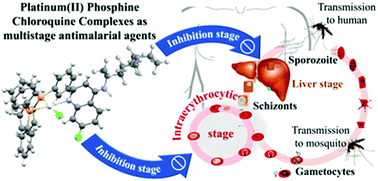当前位置:
X-MOL 学术
›
Metallomics
›
论文详情
Our official English website, www.x-mol.net, welcomes your feedback! (Note: you will need to create a separate account there.)
Platinum(II)–chloroquine complexes are antimalarial agents against blood and liver stages by impairing mitochondrial function
Metallomics ( IF 3.4 ) Pub Date : 2017-09-19 00:00:00 , DOI: 10.1039/c7mt00196g Taís S. Macedo 1, 2, 3, 4 , Wilmer Villarreal 4, 5, 6, 7 , Camila C. Couto 1, 2, 3, 4 , Diogo R. M. Moreira 1, 2, 3, 4 , Maribel Navarro 4, 6, 8, 9, 10 , Marta Machado 11, 12, 13, 14, 15 , Miguel Prudêncio 11, 12, 13, 14, 15 , Alzir A. Batista 4, 5, 6, 7 , Milena B. P. Soares 1, 2, 3, 4, 16
Metallomics ( IF 3.4 ) Pub Date : 2017-09-19 00:00:00 , DOI: 10.1039/c7mt00196g Taís S. Macedo 1, 2, 3, 4 , Wilmer Villarreal 4, 5, 6, 7 , Camila C. Couto 1, 2, 3, 4 , Diogo R. M. Moreira 1, 2, 3, 4 , Maribel Navarro 4, 6, 8, 9, 10 , Marta Machado 11, 12, 13, 14, 15 , Miguel Prudêncio 11, 12, 13, 14, 15 , Alzir A. Batista 4, 5, 6, 7 , Milena B. P. Soares 1, 2, 3, 4, 16
Affiliation

|
Chloroquine is an antimalarial agent with strong activity against the blood stage of Plasmodium infection, but with low activity against the parasite's liver stage. In addition, the resistance to chloroquine limits its clinical use. The discovery of new molecules possessing multistage activity and overcoming drug resistance is needed. One possible strategy to achieve this lies in combining antimalarial quinolones with the pharmacological effects of transition metals. We investigated the antimalarial activity of four platinum(II) complexes composed of chloroquine and phosphine ligands, denoted as WV-90, WV-92, WV-93 and WV-94. In comparison with chloroquine, the complexes were less potent against the chloroquine-sensitive 3D7 strain but they were as active as chloroquine in inhibiting the chloroquine-resistant W2 strain of P. falciparum. Regarding selectivity, the complexes WV-90 and WV-93 displayed higher indexes. Unlike chloroquine, the complexes act as irreversible parasiticidal agents against trophozoites and the WV-93 complex displayed activity against the hepatic stage of P. berghei. The in vivo suppression activity against P. berghei in the Peters 4 day test displayed by the complexes was similar to that of chloroquine. However, the efficacy in an established P. berghei infection in the Thompson test was superior for the WV-93 complex compared to chloroquine. The complexes’ antimalarial mechanism of action is initiated by inhibiting the hemozoin formation. While chloroquine efficiently inhibits hemozoin, parasites treated with the platinum complexes display residual hemozoin crystals. This is explained since the interaction of the platinum complexes with ferriprotoporphyrin is weaker than that of chloroquine. However, the complexes caused a loss of mitochondrial integrity and subsequent reduction in mitochondrial activity, and their effects on mitochondria were more pronounced than those in the chloroquine-treated parasites. The dual effect of the platinum complexes may explain their activity against the hemozoin-lacking parasites (hepatic stage), where chloroquine has no activity. Our findings indicate that the platinum(II)–chloroquine complexes are multifunctional antimalarial compounds and reinforce the importance of metal complexes in antimalarial drug discovery.
中文翻译:

铂(II)-氯喹配合物是通过破坏线粒体功能来对抗血液和肝脏阶段的抗疟药
氯喹是抗疟疾药,对疟原虫感染的血液阶段具有较强的活性,而对寄生虫的肝脏阶段具有较低的活性。另外,对氯喹的抗性限制了其临床用途。需要发现具有多阶段活性并克服耐药性的新分子。实现这一目标的一种可能策略是将抗疟药喹诺酮类与过渡金属的药理作用相结合。我们研究了四种铂(II)由氯喹和膦配体组成的复合物,表示为WV-90,WV-92,WV-93和WV-94。与氯喹相比,该配合物对氯喹敏感的3D7菌株的效力较弱,但它们在抑制恶性疟原虫抗氯喹的W2菌株方面的活性与氯喹相同。关于选择性,络合物WV-90和WV-93显示出较高的指数。与氯喹不同,该复合物对滋养体起不可逆的杀寄生虫剂的作用,而WV-93复合物则对伯氏疟原虫的肝阶段表现出活性。在体内对抑制活性伯氏疟原虫在配合物显示的Peters 4天试验中,其与氯喹相似。然而,在已建立的伯氏疟原虫中的功效与氯喹相比,汤普森试验中的WV-93复合物感染更胜一筹。该复合物的抗疟疾作用机制是通过抑制hezozoin的形成而启动的。尽管氯喹有效抑制血红蛋白,但用铂配合物处理的寄生虫显示出残留的血红蛋白晶体。这是因为铂配合物与亚铁原卟啉的相互作用比氯喹的相互作用弱。然而,该复合物导致线粒体完整性的丧失并随后降低了线粒体的活性,并且它们对线粒体的影响比氯喹处理的寄生虫中更为明显。铂配合物的双重作用可能解释了它们对缺乏血凝素的寄生虫(肝阶段)的活性,氯喹没有活性。II)–氯喹配合物是多功能的抗疟化合物,并增强了金属配合物在抗疟药物发现中的重要性。
更新日期:2017-11-16
中文翻译:

铂(II)-氯喹配合物是通过破坏线粒体功能来对抗血液和肝脏阶段的抗疟药
氯喹是抗疟疾药,对疟原虫感染的血液阶段具有较强的活性,而对寄生虫的肝脏阶段具有较低的活性。另外,对氯喹的抗性限制了其临床用途。需要发现具有多阶段活性并克服耐药性的新分子。实现这一目标的一种可能策略是将抗疟药喹诺酮类与过渡金属的药理作用相结合。我们研究了四种铂(II)由氯喹和膦配体组成的复合物,表示为WV-90,WV-92,WV-93和WV-94。与氯喹相比,该配合物对氯喹敏感的3D7菌株的效力较弱,但它们在抑制恶性疟原虫抗氯喹的W2菌株方面的活性与氯喹相同。关于选择性,络合物WV-90和WV-93显示出较高的指数。与氯喹不同,该复合物对滋养体起不可逆的杀寄生虫剂的作用,而WV-93复合物则对伯氏疟原虫的肝阶段表现出活性。在体内对抑制活性伯氏疟原虫在配合物显示的Peters 4天试验中,其与氯喹相似。然而,在已建立的伯氏疟原虫中的功效与氯喹相比,汤普森试验中的WV-93复合物感染更胜一筹。该复合物的抗疟疾作用机制是通过抑制hezozoin的形成而启动的。尽管氯喹有效抑制血红蛋白,但用铂配合物处理的寄生虫显示出残留的血红蛋白晶体。这是因为铂配合物与亚铁原卟啉的相互作用比氯喹的相互作用弱。然而,该复合物导致线粒体完整性的丧失并随后降低了线粒体的活性,并且它们对线粒体的影响比氯喹处理的寄生虫中更为明显。铂配合物的双重作用可能解释了它们对缺乏血凝素的寄生虫(肝阶段)的活性,氯喹没有活性。II)–氯喹配合物是多功能的抗疟化合物,并增强了金属配合物在抗疟药物发现中的重要性。



























 京公网安备 11010802027423号
京公网安备 11010802027423号